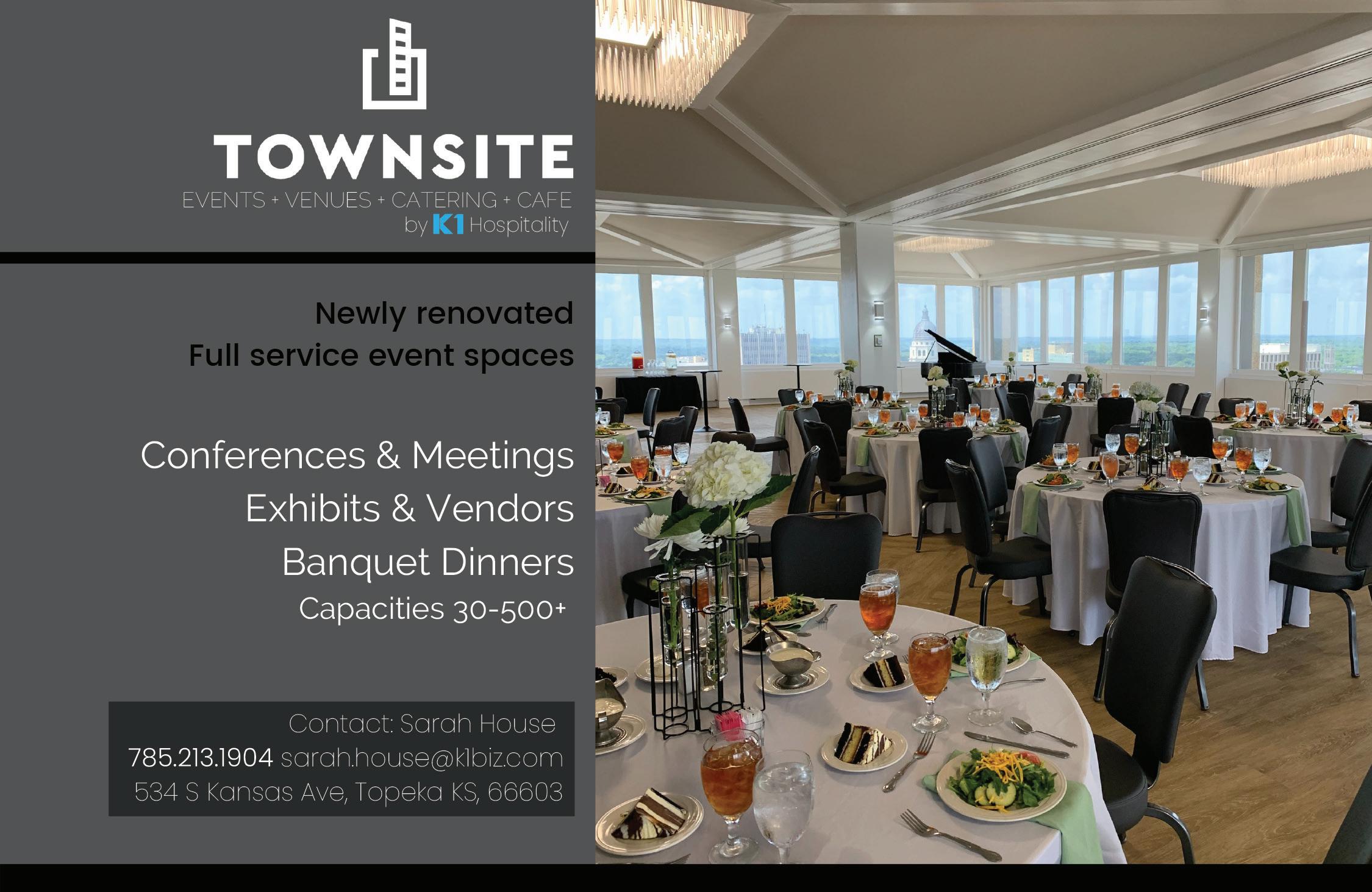
8 minute read
SOLUTIONS
INCORPORATING VIDEO FOR ASSOCIATION COMMUNICATION
By Liz Stevens, contributing writer, KSAE Magazine
It’s time to get ready for the association’s close-up. Some nonprofits may have dragged their feet about using video as a communication tool, but nowadays everyone is more comfortable in front of the camera. There are Zoom meetings, classroom webinars, remote court appearances, virtual happy hours and video birthday parties. Videos really are an effective way to communicate. They make it easier to grab attention and build an audience, and savvy nonprofits are learning about the value of “lights, camera, action.”
In an Association Management Center (AMC) blog1, Carly Mangus, assistant editor and resident video editor, Creative Media Services at AMC, explained the value of video for associations. “Video is the most effective way to reach your audience,” Mangus wrote, “as it establishes trust, communicates your brand and delivers information more effectively than any other medium. It shows the personality of your organization and makes the audience feel more connected, not only to the cause or mission, but to the people making it all happen.”
Mangus noted that in a world where attention spans are measured in mere seconds, internet video can keep watchers’ attention for nearly three minutes. “Visual content is more likely to be engaged with for longer periods of time and shared on social media,” Mangus wrote, “and video content is more likely to rank your organization on the first page of a Google Search than standard text.” So, video defies the attention span threshold, boosts one’s Google Search placement and often is shared. A creative-minded association can use videos for many types of communication. A video can contain a message from the board, an overview of the association and its mission or a Q&A session fielded by the association team. A video could describe a new campaign, lay out the success of a just-finished push or feature the benefactors of an association’s well-met goal.
In “How Your Association Can Use Video to Engage Members,”2 Brianna Lawson wrote that associations can use videos to present their professional education offerings. Lawson also stressed that videos can be a new way to convey content or to target a hard-to-reach new group for membership. “Video can attract new members, especially younger ones,” Lawson wrote. “Featuring videos of members from your association talking about what they are excited about that relates to the industry allows younger individuals to more easily identify with your association – because they share the same interests as your current members.” And Lawson pointed out that a video might be a terrific way to simultaneously build brand awareness for the association and spotlight important advertisers and sponsors.
There are plenty of avenues for sharing association videos. One of the easiest ways is to post videos on the association’s website and to ask staff and volunteers to share videos on their social media platforms. Videos can be included as links in emails and email newsletters. Popular social media sites on which to share videos include Facebook, YouTube, Twitter and Instagram.

Features Rooftop Glass-Bo om Suspended Pool Onsite Starbucks Scenic City View Event Space Wichita Downtown

Microwave, Keurig Coff eemaker & Mini Refrigerator 50" Television Complimentary WiFi • 10,000 sq. ft of meeting and event space Restaurant & 401 Bar • 24-hour Shop • ATM Onsite • Indoor Pool & Fitness Center
Topeka

Features Outdoor Game Area and Gazebo

Microwave, Keurig Coff eemaker & Mini Refrigerator • 50" Television Complimentary WiFi • Meeting and Event Space • 24-hour Shop Restaurant & 34th Star Bar • ATM Onsite • Indoor Pool & Fitness Center
1351 SW Arvonia Place Topeka, KS 66615 785.350.2069 hgitopeka.hgi.com 401 East Douglas Wichita, KS 67202 316.669.6175 wichitadowntown.hgi.com
continued from page 30
The strategy for preparing and launching a single video or a video campaign will be familiar to associations because strategizing for video includes some of the same decisions as strategizing for recruiting or fundraising. Communications managers should ponder these four big questions: What is the goal, what is the topic, what are the key points to keep in mind and how will success be measured?
What is the goal?
In “Tips for Creating a Nonprofit Video Marketing Strategy,”3 Mina Poyraz discusses fundraising as a goal for using video, and also brings up other end results. “Think about your goal and what you expect for your video marketing outcome,” Poyraz wrote. “Video is often perceived as a tool to create awareness, but it can do more than just that for nonprofits. Think about using video to increase your fundraising.” Poyraz noted that Google calls online video the best online method for driving donations, with more than 50% of donors making a donation after viewing video on a favorite nonprofit cause. Poyraz also pointed to video as an effective way to direct traffic back to a nonprofit’s website and to increase its follower base.
In a Wild Apricot blog, “The Ultimate Nonprofit Video Marketing Strategy + 5 of the Best Nonprofit Videos We’ve Seen,”4 Tatiana Morand urged nonprofits to answer one preeminent question before diving into video production: What am I hoping to achieve with this video? To explore this key point in more depth, Morand suggested addressing three additional questions: who is the audience for the video, how many videos will be produced and who is available to help with this project? “Writing down these answers and keeping them top of mind will help you stay focused on the kind of content you’re going to create (and ensures you won’t get in over your head),” wrote Morand.
What is the topic?
Once an association has a result in mind for creating a video, it is time to consider which type of topic will best tell the nonprofit’s story and elicit the desired response from viewers. Morand’s article touched on this question and offered suggestions.
A video might tell the story of an association’s raison d’ etre – its underlying cause – or it might illustrate the professional or social need that prompted the creation of the association. A video could showcase an association’s team members or testimonials from the people who benefitted from the association’s hard work. A video might announce an event and invite attendees, or it might be a thank you offered to the association’s most generous donors.
What are the key elements?
Some of the elements that make for great theater or movies carry through to making a great video. A compelling film or Communications managers should ponder these four big questions: What is the goal, what is the topic, what are the key points to keep in mind and how will success be measured?
play or nonprofit video relies on storytelling skill, a strong story, passion (as in a deep sense of purpose or gravitas), relatable and memorable characters, and content that evokes the senses and touches the audience’s emotions. An association’s video will go a step further than entertainment since it will aim to reach and impact its own community and extend a simple call-to-action.
Mobile Cause described the value of these ingredients in “Smartphones Make It Easy for Nonprofits To Create Professional Looking Fundraising Videos.”5 “When you highlight your organization’s core messaging in a real, authentic way, you give viewers the opportunity – and inspiration – to get involved with your nonprofit on an emotional level and encourage them to volunteer time and resources to your cause.
Key Components of the Best Fundraising Videos: • Evoke the senses when telling your story with images and stories that give viewers a reason to believe in your cause. • Relatability is key, so tap into what resonates by creating a familiar persona that incorporates your organization’s message and aspirations. • Cast powerful characters, passionate people from your org or benefiting from your mission to create empathy to help viewers relate to and get them behind your cause. • Know your audience. Target your story for a direct and specific purpose – if you don’t know who you’re talking to, the right people won’t be listening. • Passion is paramount, so keep your purpose in mind and add in some depth to match the tone and feel of your organization. • Humility helps everyone – connect your audience to your organization in a sincere way to create trust in your mission and get people involved.”
How will success be measured?
Theaters that stage plays and movie houses that show films measure success by box office receipts. Associations don’t have a box office, per se, but they can measure the success of video projects by the number of donations or the total amount of donations they receive as a result of sharing a video.
Other ways to measure success include the number of video views, the total amount of time (hours and minutes) all viewers spent watching a video, the “likes” or YouTube subscribers earned, or the number of new members that join the association after watching a video.
The measure of success, of course, will be tied directly to the overall goal of the video or video campaign. Examining the success (or lack thereof) for a video will help an association decide whether to do more of the same or change things up for better results.
To get the creative juices flowing, here are a few ideas from backtoyoumarketing.com6, Carly Mangus’s blog and Tatiana Morand’s blog for video content that might be just the thing to script, produce and share:
• Telling the organization’s story • Time-lapse (of an event or project) • Videos about partner organizations • Event invitations or recaps • Sharing the association’s mission • Explaining an aspect of the association’s work • Report summaries • Holiday greetings • Stories from passionate association members • Highlighting the nonprofit’s impact F
References
1. Carly Mangus, “Why Video Content is Important for Your
Association,” Association Management Center blog. http:// connect2amc.com/68-why-video-content-is-important-foryour-association. 2. Brianna Lawson, “How Your Association Can Use Video to
Engage Members,” May 2, 2015. https://www.naylor.com/ associationadviser/video-to-engage-members/. 3. Mina Poyraz, “Tips for Creating a Nonprofit Video Marketing
Strategy,” April 3, 2018. https://mediacause.org/videomarketing-nonprofits/. 4. Tatiana Morand, “The Ultimate Nonprofit Video Marketing
Strategy + 5 of the Best Nonprofit Videos We’ve Seen,”
July 20, 2018. https://www.wildapricot.com/blogs/ newsblog/2018/07/20/nonprofit-video-marketing-strategy 5. “Smartphones Make It Easy for Nonprofits to Create
Professional Looking Fundraising Videos,” Online Fundraising:
The Beginner’s Guide for Nonprofits; Chapter Six: Fundraising
Videos. https://www.mobilecause.com/online-fundraisingguide/fundraising-videos/. 6. Stephen Koranda, “22 (More) Easy Video Content Ideas,”
October 4, 2018. http://backtoyoumarketing.com/22-videocontent-ideas/.








